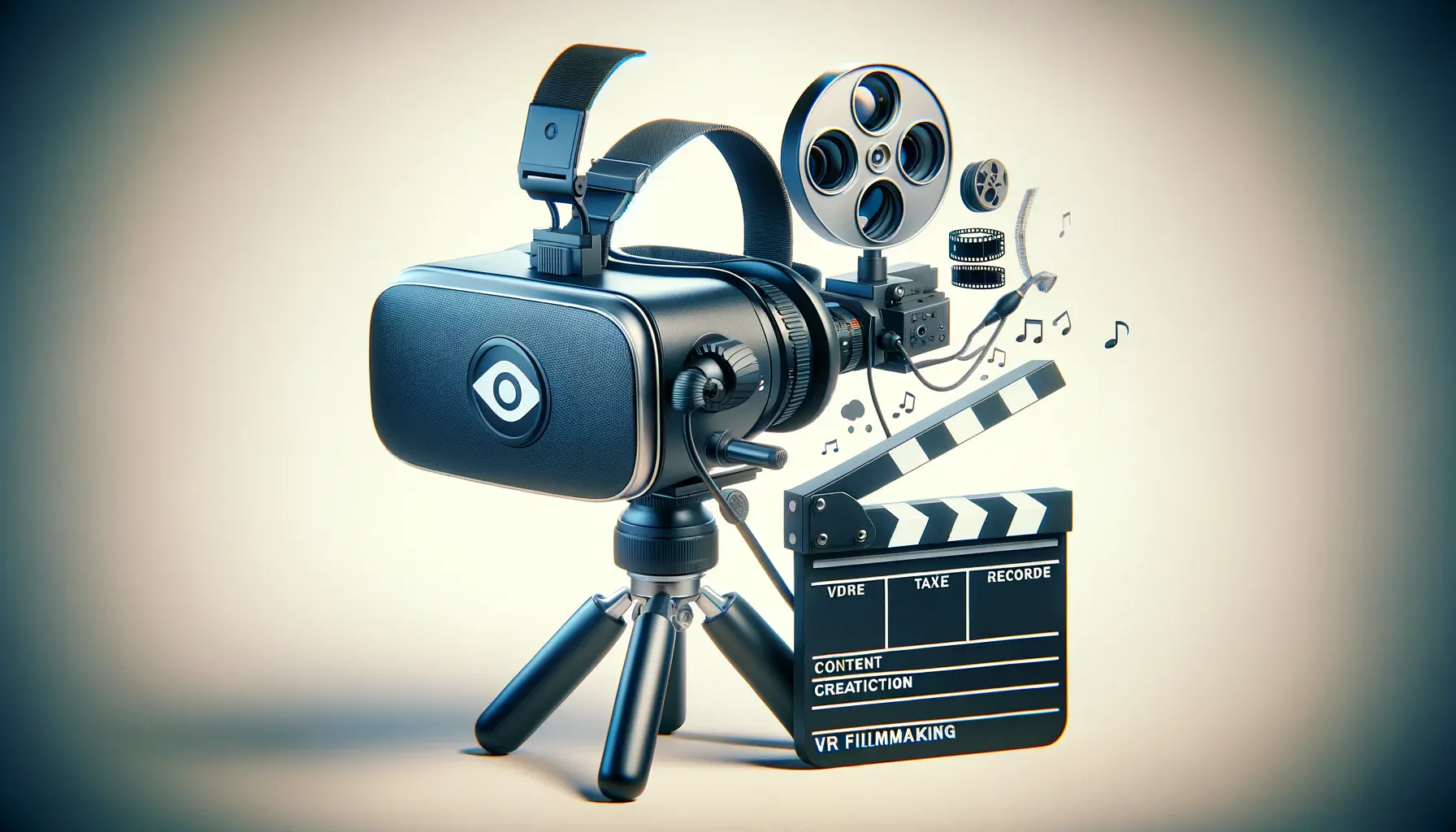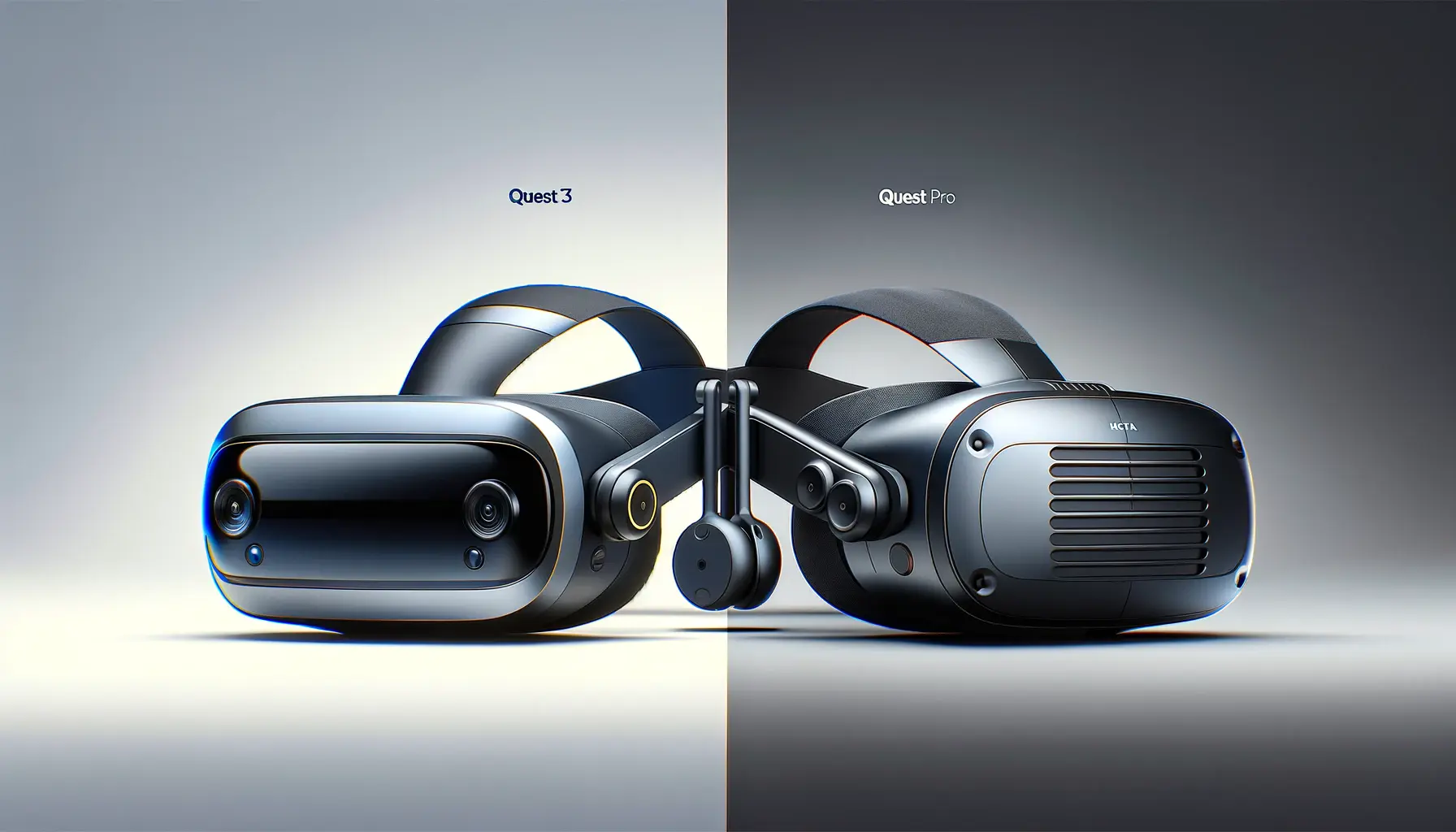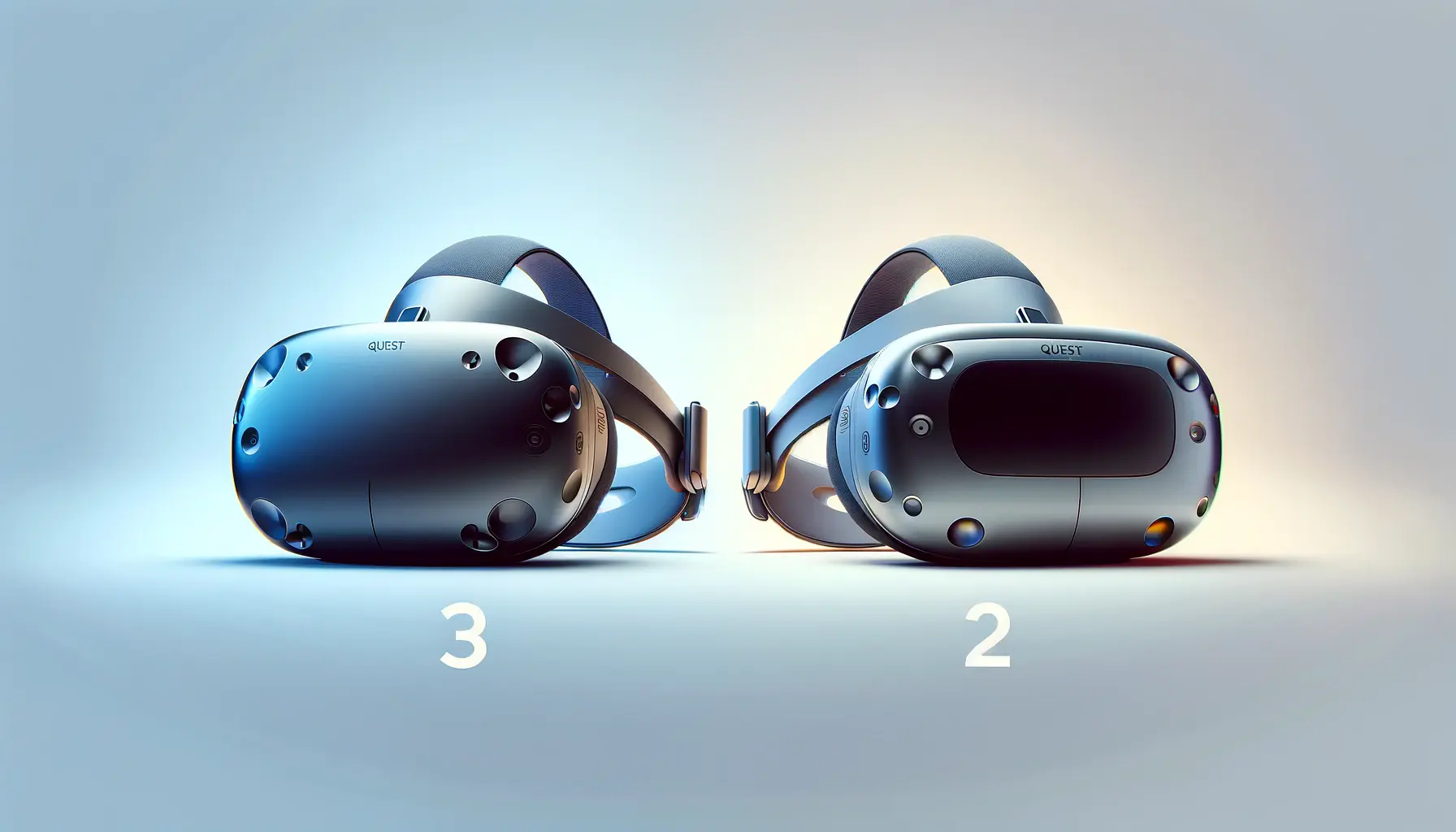The advent of the Meta Quest 3 has ushered in a new era of virtual reality (VR) experiences, transforming the way we perceive, create, and interact with digital content.
This cutting-edge technology not only enhances the immersive experience for users but also opens up a plethora of opportunities for content creators, especially in the realm of VR filmmaking.
The Quest 3, with its advanced features and capabilities, is poised to revolutionize the content creation landscape, offering filmmakers a unique platform to craft their stories in a more engaging and immersive manner.
VR filmmaking on the Quest 3 platform is not just about the novelty of immersive experiences; it’s a transformative approach to storytelling, enabling creators to bring their audiences into the heart of the narrative.
This technology allows for a level of engagement and interaction previously unattainable with traditional filmmaking techniques.
As we delve deeper into the capabilities of the Quest 3, it becomes evident that this device is not merely a tool for entertainment but a powerful medium for storytelling, education, and artistic expression.
- Exploring the Capabilities of Quest 3 for Filmmakers
- Enhancing Visuals with Quest 3’s VR Capabilities
- Interactive Storytelling and Audience Engagement
- Challenges and Solutions in VR Filmmaking
- Integrating Sound Design in VR Filmmaking
- Marketing and Distribution Strategies for VR Content
- Future Trends in VR Filmmaking with Quest 3
- Embracing the Future of VR Filmmaking with Quest 3
- Quest 3 VR Filmmaking: Frequently Asked Questions
Exploring the Capabilities of Quest 3 for Filmmakers
Advanced Hardware and Software Integration
The Meta Quest 3 stands out with its seamless integration of hardware and software, providing filmmakers with a robust platform for VR content creation.
The device’s high-resolution display and powerful processing capabilities ensure that creators can produce and render high-quality VR content efficiently.
This integration facilitates a smooth content creation process, from conceptualization to final output, enabling filmmakers to focus on their creative vision without being hindered by technical limitations.
Moreover, the Quest 3’s intuitive user interface and accessible development tools lower the barrier to entry for filmmakers new to VR content creation.
This democratization of technology means that more creators can experiment with VR filmmaking, leading to a richer and more diverse range of VR content available to audiences.
Immersive Storytelling Tools
One of the most significant advantages of the Quest 3 for filmmakers is its suite of immersive storytelling tools.
These tools allow creators to design interactive narratives where viewers can choose their path through the story, creating a personalized viewing experience.
This level of interactivity introduces a new dimension to storytelling, where the audience becomes an active participant in the narrative.
The Quest 3 also supports spatial audio, adding depth and realism to the VR experience.
This feature is crucial for filmmakers, as it enables them to craft soundscapes that enhance the immersive quality of their films, making viewers feel as if they are truly part of the story.
The Quest 3’s advanced features, such as high-resolution displays, powerful processing, and immersive storytelling tools, offer filmmakers a unique platform to push the boundaries of traditional storytelling and engage with their audience in unprecedented ways.
Enhancing Visuals with Quest 3’s VR Capabilities
The Meta Quest 3’s technological advancements significantly enhance the visual aspects of VR filmmaking, providing content creators with the tools to produce visually stunning and immersive experiences.
The device’s capabilities in rendering high-quality graphics and supporting advanced visual effects open new avenues for creative expression in VR content creation.
High-Quality Graphics and Rendering
At the core of the Quest 3’s appeal to filmmakers is its ability to render high-quality graphics in real-time.
This capability is crucial for creating immersive environments that captivate viewers and transport them into the world of the film.
The Quest 3’s powerful GPU ensures that even the most detailed and complex scenes are rendered smoothly, maintaining the illusion of reality that is essential for immersive VR experiences.
Furthermore, the support for advanced lighting and shading techniques allows filmmakers to experiment with mood and atmosphere, enhancing the storytelling aspect of their VR films.
These technical features enable creators to bring their artistic visions to life with a level of detail and realism previously unattainable in VR filmmaking.
Utilizing 360-Degree Video
The Quest 3 excels in supporting 360-degree video content, a cornerstone of VR filmmaking.
This feature allows filmmakers to craft stories that fully envelop the viewer, creating a sense of presence within the narrative.
By filming in 360 degrees, creators can ensure that viewers are not just observers but are placed at the center of the action, offering a truly immersive experience.
- Interactive Elements: The Quest 3 enables the incorporation of interactive elements within 360-degree videos, allowing viewers to influence the story’s outcome or explore the environment more freely. This interactivity adds a layer of engagement that is unique to VR filmmaking.
- Spatial Audio Integration: Coupled with spatial audio, 360-degree videos on the Quest 3 create a convincing and enveloping world. This audiovisual integration is key to producing immersive content that engages all the viewer’s senses.
Incorporating high-quality graphics, advanced rendering techniques, and 360-degree video capabilities, the Quest 3 offers filmmakers a comprehensive toolkit for creating visually captivating and deeply immersive VR films.
Interactive Storytelling and Audience Engagement
The Meta Quest 3’s innovative technology not only enhances the visual and auditory experience of VR filmmaking but also redefines narrative structures through interactive storytelling.
This approach transforms viewers from passive observers into active participants, significantly increasing audience engagement and investment in the story.
Interactive storytelling in VR offers a unique set of challenges and opportunities for filmmakers.
The Quest 3, with its advanced features, provides the perfect platform for exploring these new narrative possibilities.
By leveraging the device’s capabilities, creators can design experiences that respond to the viewer’s decisions and movements, creating a personalized narrative journey for each audience member.
Branching Narratives and Decision Points
One of the most exciting aspects of interactive storytelling on the Quest 3 is the ability to create branching narratives.
This narrative structure allows viewers to make choices at key decision points, which in turn influences the direction and outcome of the story.
Such a level of interactivity ensures that no two viewing experiences are the same, encouraging repeat engagement and deeper exploration of the narrative.
The implementation of decision points requires careful planning and scripting to ensure a cohesive and engaging story, regardless of the choices made by the viewer.
The Quest 3’s development tools support this complex narrative design, enabling filmmakers to craft intricate stories that are both immersive and interactive.
Enhancing Engagement with Gamification Elements
Incorporating gamification elements into VR films is another effective way to increase viewer engagement.
These elements, such as puzzles, challenges, and rewards, add an extra layer of interaction, motivating viewers to actively participate in the narrative.
The Quest 3’s versatile platform supports the integration of these gamification features, allowing creators to experiment with different engagement strategies.
- Challenges and Puzzles: Introducing challenges or puzzles that viewers must solve to progress in the story adds a sense of achievement and encourages active participation.
- Rewards and Unlockables: Offering rewards or unlockable content based on viewer choices or achievements can enhance the sense of immersion and personal investment in the narrative.
Interactive storytelling on the Quest 3 not only enriches the viewer’s experience through engagement and personalization but also opens up new creative avenues for filmmakers to explore narrative depth and complexity.
Challenges and Solutions in VR Filmmaking
While the Meta Quest 3 offers groundbreaking opportunities for VR filmmaking, creators face unique challenges in this emerging medium.
These challenges range from technical limitations to narrative complexity, requiring innovative solutions to fully leverage the potential of VR content creation.
Understanding these challenges is crucial for filmmakers who wish to push the boundaries of what is possible in VR.
By addressing these issues head-on, creators can harness the full power of the Quest 3 to produce compelling, immersive content that transcends traditional filmmaking paradigms.
Technical Limitations and Hardware Constraints
One of the primary challenges in VR filmmaking is navigating the technical limitations and hardware constraints of current VR technology.
Despite the advanced capabilities of the Quest 3, filmmakers must still contend with issues such as limited battery life, storage capacity, and the need for high-quality, VR-ready assets that can strain the device’s processing power.
Solutions to these challenges include optimizing content for VR, utilizing cloud-based storage and processing solutions, and developing efficient workflows that minimize the impact of hardware constraints on the creative process.
By adopting these strategies, filmmakers can overcome technical limitations and focus on crafting immersive VR experiences.
Navigating Narrative Complexity
Another significant challenge in VR filmmaking is managing the complexity of interactive narratives.
Creating a story that adapts to viewer choices without becoming disjointed or losing narrative coherence requires careful planning and innovative storytelling techniques.
To address this challenge, filmmakers can employ branching narrative structures, modular story design, and adaptive storytelling algorithms that respond dynamically to viewer interactions.
These approaches allow for a seamless integration of interactivity into the narrative, ensuring a cohesive and engaging story regardless of the viewer’s decisions.
Ensuring Viewer Comfort and Accessibility
Ensuring viewer comfort and accessibility is paramount in VR filmmaking.
Issues such as motion sickness, user interface design, and accessibility for viewers with disabilities can significantly impact the viewer’s experience.
- Implementing best practices for VR design, such as avoiding rapid movements and providing clear navigation cues, can help mitigate motion sickness.
- Designing accessible interfaces and incorporating adjustable settings allows filmmakers to cater to a wider audience, including those with disabilities.
By addressing the challenges of technical limitations, narrative complexity, and viewer comfort, filmmakers can create VR experiences that are not only immersive and engaging but also accessible and enjoyable for a broad audience.
Integrating Sound Design in VR Filmmaking
The immersive nature of VR filmmaking on platforms like the Meta Quest 3 demands a reevaluation of traditional sound design principles.
In VR, audio plays a crucial role in establishing a sense of presence and immersion, making it an essential element of the filmmaking process.
The spatial audio capabilities of the Quest 3 allow filmmakers to craft soundscapes that envelop the viewer, enhancing the narrative and emotional impact of the VR experience.
Effective sound design in VR involves more than just high-quality audio; it requires a strategic approach to utilizing sound to guide the viewer’s attention, convey mood, and enhance the storytelling.
The Quest 3’s audio technology provides the tools necessary to achieve these goals, offering a new dimension of creative possibilities for filmmakers.
Creating Immersive Soundscapes
The ability to create immersive soundscapes is one of the most powerful features of the Quest 3.
By using spatial audio, filmmakers can place sounds in a 3D space, making it possible for viewers to locate the source of a sound within the VR environment.
This level of audio detail adds depth to the virtual world, making it feel more real and tangible.
Moreover, immersive soundscapes can be used to direct the viewer’s attention to specific elements of the scene or to subtly guide them through the narrative.
This technique is particularly effective in interactive VR experiences, where the direction of the story may depend on the viewer’s focus and decisions.
Enhancing Emotional Impact with Audio
Sound design in VR also plays a critical role in enhancing the emotional impact of the story.
The Quest 3’s advanced audio capabilities allow filmmakers to use sound in nuanced ways to evoke specific emotions or create atmospheric tension.
Whether it’s the eerie silence of an abandoned space or the comforting sounds of nature, audio can significantly affect the viewer’s emotional response to the VR film.
- Utilizing music and sound effects strategically can amplify key moments in the narrative, making them more memorable and impactful.
- Designing audio cues that respond to the viewer’s actions or choices in interactive experiences can create a more personalized and emotionally engaging story.
Integrating advanced sound design techniques with the Quest 3’s spatial audio capabilities offers filmmakers a powerful tool to enhance immersion, guide narrative flow, and evoke emotional responses, elevating the VR filmmaking process to new heights.
Marketing and Distribution Strategies for VR Content
In the evolving landscape of VR filmmaking, creating compelling content with the Meta Quest 3 is only part of the equation.
Equally important is the strategy for marketing and distributing this content to reach the widest possible audience.
The unique nature of VR content requires innovative approaches to promotion and distribution, leveraging both traditional channels and VR-specific platforms to maximize visibility and engagement.
Understanding the best practices for marketing and distributing VR films can help creators navigate the complexities of the VR market, ensuring their content stands out in a crowded space.
This involves not only showcasing the immersive qualities of VR content but also making it accessible to potential viewers across various platforms.
Leveraging Social Media and Online Platforms
Social media and online platforms play a crucial role in the marketing and distribution of VR content.
Creating engaging teasers, trailers, and behind-the-scenes content that highlight the unique aspects of VR filmmaking can generate interest and anticipation among potential viewers.
Platforms like YouTube, Instagram, and Twitter offer valuable opportunities to reach a broad audience and direct them to VR content platforms.
Additionally, leveraging VR-specific forums and communities can help target enthusiasts who are more likely to engage with and promote VR content.
Engaging with these communities through discussions, Q&A sessions, and exclusive previews can build a loyal following for VR projects.
Collaborating with VR Platforms and Festivals
Collaboration with VR platforms and participation in VR film festivals are effective strategies for distributing VR content.
Platforms dedicated to VR, such as Oculus Store or SteamVR, provide a direct channel to reach VR users, offering filmmakers the opportunity to showcase their work to an engaged and interested audience.
- Submitting VR films to festivals dedicated to virtual and augmented reality can also increase visibility among industry professionals and enthusiasts, potentially leading to further distribution opportunities and collaborations.
- Partnerships with VR arcades and experience centers can offer a physical venue for showcasing VR films, allowing viewers to experience content in a fully equipped VR setting.
Assuming that traditional marketing and distribution strategies alone are sufficient for VR content can limit its reach and impact. Embracing VR-specific channels and communities, along with innovative promotion techniques, is essential for the success of VR filmmaking projects.
Future Trends in VR Filmmaking with Quest 3
The landscape of VR filmmaking is continuously evolving, with the Meta Quest 3 at the forefront of this innovation.
As technology advances and creators become more familiar with the possibilities of VR, we are likely to see new trends emerge in VR filmmaking.
These trends will not only push the boundaries of what’s possible in virtual storytelling but also shape the future of the medium itself.
Understanding these potential future trends is crucial for filmmakers and content creators who wish to stay ahead in the VR content creation space.
By anticipating the direction in which VR filmmaking is headed, creators can better position themselves to take advantage of new opportunities and technologies as they arise.
Increased Emphasis on Interactivity and Personalization
One of the most significant trends in VR filmmaking is the move towards greater interactivity and personalization.
As the technology behind VR becomes more sophisticated, filmmakers will have more tools at their disposal to create experiences that adapt to the viewer’s choices and preferences.
This could lead to a more personalized storytelling experience, where the narrative changes based on the viewer’s interactions within the VR environment.
The Quest 3’s capabilities in tracking user movements and decisions will play a key role in this trend, enabling more complex and responsive narrative structures.
This shift towards interactive storytelling will likely increase viewer engagement and immersion, making VR films more compelling and memorable.
Integration of Mixed Reality Experiences
Another emerging trend is the integration of mixed reality (MR) experiences into VR filmmaking.
By blending real-world elements with virtual environments, filmmakers can create more immersive and believable narratives.
The Quest 3’s support for MR content opens up new possibilities for storytelling, allowing creators to merge physical and digital worlds in innovative ways.
- Augmented reality (AR) elements can be used to enhance the storytelling experience, adding an extra layer of interactivity and immersion.
- The use of MR in filmmaking can also facilitate more natural interactions within the VR environment, making the virtual world feel more connected to the real world.
Advancements in AI and Machine Learning
The integration of artificial intelligence (AI) and machine learning technologies into VR filmmaking is a trend that holds significant potential.
AI can be used to generate dynamic content that adapts to the viewer’s behavior, create realistic virtual characters, and even assist in the editing and post-production processes.
As these technologies continue to develop, they will offer filmmakers new ways to enhance storytelling and create more engaging VR experiences.
The Quest 3’s platform, with its powerful processing capabilities, is well-suited to support these advancements, making it an ideal tool for exploring the future possibilities of VR filmmaking.
As VR technology continues to evolve, filmmakers must remain adaptable and open to exploring new trends and techniques. The future of VR filmmaking with the Quest 3 promises a landscape of endless creative possibilities, where the only limit is the imagination of the creators.
Embracing the Future of VR Filmmaking with Quest 3
The journey through the capabilities, challenges, and future trends of VR filmmaking with the Meta Quest 3 reveals a landscape ripe with opportunities for innovation, creativity, and engagement.
As we’ve explored, the Quest 3 is not just a tool for immersive entertainment but a platform that empowers filmmakers to push the boundaries of traditional storytelling, offering audiences experiences that are more engaging, interactive, and personal than ever before.
The Evolution of Content Creation
The advancements in VR technology, as exemplified by the Quest 3, have significantly altered the content creation landscape.
Filmmakers now have at their disposal an array of features and capabilities that enable the production of content that is not only visually stunning and immersive but also interactive and personalized.
This shift towards a more engaging form of storytelling marks a pivotal evolution in how stories are told and experienced.
Overcoming Challenges with Innovation
Despite the exciting possibilities, VR filmmaking with the Quest 3 presents its own set of challenges.
From technical limitations to the complexities of interactive narrative design, creators must navigate a variety of obstacles.
However, as we’ve seen, these challenges are not insurmountable.
Through innovative solutions, such as optimizing content for VR, employing branching narratives, and ensuring viewer comfort, filmmakers can overcome these hurdles, paving the way for groundbreaking VR experiences.
Looking Ahead: The Future of VR Filmmaking
The future of VR filmmaking with the Quest 3 is bright, with emerging trends like increased interactivity, the integration of mixed reality experiences, and the application of AI and machine learning promising to further revolutionize the field.
These advancements suggest a future where VR films are not only more immersive and engaging but also more accessible and tailored to individual viewers.
- The emphasis on interactivity and personalization will likely deepen the viewer’s connection to the narrative, making VR films more impactful and memorable.
- Mixed reality experiences will blur the lines between the digital and physical worlds, creating new opportunities for storytelling that are grounded in reality yet limitless in imagination.
- Advancements in AI and machine learning will streamline the content creation process, enabling more dynamic and responsive narratives.
In conclusion, the Meta Quest 3 stands at the forefront of a new era in filmmaking, one that challenges traditional notions of storytelling and audience engagement.
By leveraging the capabilities of the Quest 3, filmmakers have the opportunity to explore uncharted territories of creativity and innovation.
As technology continues to evolve, so too will the possibilities for VR filmmaking, promising a future where the stories we tell are limited only by our imagination.
The journey with the Quest 3 is just beginning, and it’s an exciting time to be a part of this transformative medium.
Quest 3 VR Filmmaking: Frequently Asked Questions
Explore the most common inquiries about VR filmmaking with the cutting-edge Quest 3, designed to offer in-depth insights into the latest in immersive storytelling.
The Meta Quest 3 revolutionizes VR filmmaking by offering advanced, immersive content creation tools, enabling filmmakers to craft deeply engaging and visually stunning experiences.
Yes, the Quest 3 supports 3D video recording, allowing for the creation of rich, immersive content that captures the essence of the environment in a more lifelike form.
Through its advanced features, the Quest 3 enhances interactive storytelling by enabling creators to develop narratives that respond to viewer interactions, offering a personalized experience.
Best practices include optimizing for immersion, ensuring high-quality audio and visuals, leveraging interactivity, and maintaining user comfort to create compelling VR content on the Quest 3.
Yes, the Quest 3 is equipped for live VR streaming, enabling filmmakers and creators to broadcast immersive experiences in real-time to a global audience.
Main challenges include navigating the system’s hardware limitations, managing the complexity of immersive narratives, and ensuring the content is accessible and comfortable for a wide range of viewers.
Spatial audio in Quest 3 VR filmmaking works by simulating real-world sound within a 3D space, providing a sense of place and movement that enhances the viewer’s immersion and connection to the content.
Emerging trends include the integration of mixed reality, the use of AI for dynamic content creation, and a greater focus on interactivity and personalization, driving the next evolution of VR filmmaking.














